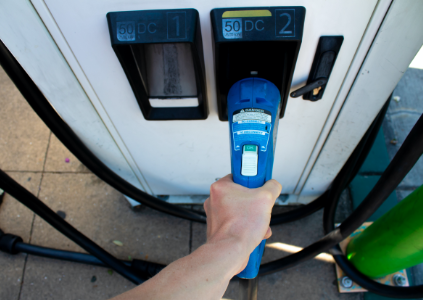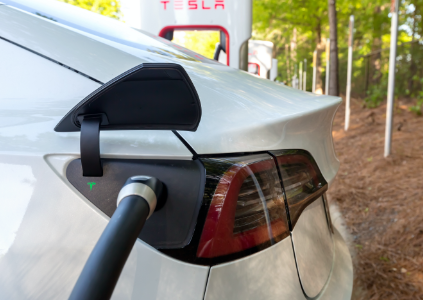EV Charging
You may have heard about range anxiety, the fear that your electric vehicle won’t get you to your destination. That isn’t a problem for Plug-in Hybrid (PHEV) vehicles—you just visit a gas station. And it’s not much of a problem for Battery Electric (BEV) vehicles, either. On average, Americans drive less than 30 miles a day, well within the range of an EV. And the decision of where and when to charge the vehicle—either at home or at a public EV charging station—is getting easier every day.
To compare the electric vehicles on the market, see our list of Electric Vehicles. To see a map of public charging stations, visit Plug-In America.

HOME EV CHARGING
Many electric vehicles are charged only at home.
Connecting to a standard household electrical outlet is practical for charging any EV when time is not a factor. But many EV drivers may want to install a Level 2—240-volt AC charger to increase charging speed. See the Types of Electric Vehicle Chargers section below for more details.
Level 2 charging stations should be installed by a professional EV charger installer. Many local governments and utilities offer EV charger incentives and rebates for the purchase or installation of these units.
About Time-of-Use Rates and Off-Peak Electricity Hours
Worried about how much it costs to charge an EV at home? Don't be! Studies have proven that the cost-per-hour rate to charge an electric car is much lower than the per-gallon price of gasoline. Some utilities also offer special time-of-use (TOU) rates for EV charging to further reduce those costs.
Simply plugging in your EV or PHEV outside of electricity peak hours can dramatically reduce your monthly electric bills. Many EVs even have software that enables you to charge your vehicle when off-peak electricity rates are lowest.
Learn more about your utility company's TOU rates and off-peak charging hours.

PUBLIC CHARGING STATIONS
Where can you charge your vehicle away from home? There are many public options available beyond your garage’s EV wall charger:
- Some workplaces offer EV charging for their employees.
- Some municipalities and utilities have installed public charging stations to encourage EV use.
- EV retailers often have charging stations at their facilities.
- Private businesses sometimes make them available for their customers.
Most of these chargers are medium-speed Level 2—240-volt AC chargers. Prices for use vary.

There are also large networks of charging stations with high speed Level 3—DC Fast chargers. Many are located near shopping and dining outlets where you can pass the time while charging.
Among the bigger networks operating in California are:
Payment is generally made through an app or smart card linked to a credit card account. The apps include maps of all EV charging stations within their network, and sometimes others as well.
Other organizations offer online maps showing a fuller range of charging stations, like Plug-In America.
The number of charging stations is growing rapidly, so check these maps regularly for updates.

TYPES OF ELECTRIC VEHICLE CHARGERS
Charging stations for electric vehicles come in three levels:
- Level 1 (120-volt AC)
- All EVs can be charged on a standard household electrical outlet.
- Charging time is longer for Level 1 chargers vs. other charger types. However, a 120-volt 15-amp home circuit charging for 8 hours will give a full BEV 46 miles of range, more than the daily need. And when you charge overnight, many utilities offer a time-of-use rate that makes it even more affordable.
- Level 2 (240-volt AC)
- Most home and public electric vehicle charging stations in California operate at 240 volts.
- Level 2 charging charges much quicker than Level 1 and can fully charge any EV overnight
- Level 3 (DC Fast)
- DC Fast chargers can add significant range to your EV in minutes rather than hours.
- Level 3 chargers come in three varieties, and there are restrictions on which vehicles can use them:
- Tesla chargers—called Superchargers—can only be used by Tesla vehicles.
- CHAdeMO chargers—are the standard for Asian brands—with a proper adapter, they work as Tesla chargers, too.
- CCS chargers with Combo plugs are the American and European standard—they work for Tesla vehicles, too.
- Many electric vehicle charging stations offer both CHAdeMO and CCS.
- Please note, DC Fast charging may be an optional extra for your vehicle.